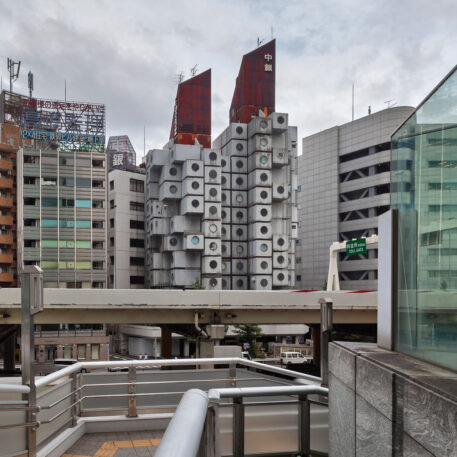
18 Sep The world’s most unconventional use of business cards
Should weird architecture be preserved? Often more expensive to maintain and less versatile than many contemporary buildings, groundbreaking architecture from the past is perpetually threatened with demolition. Advocates, meanwhile, insist that it should be maintained on historical and sentimental value alone.
This is the challenge facing the Nakagin Capsule Tower Preservation and Restoration Project, a group led by building occupants who oppose the long-threatened demolition of what is one of Japan’s most famous, if challenging, pieces of architecture.

Poking out of the glass and steel of Tokyo’s central Ginza district, the Nakagin Capsule Tower is a tower of 140 individually inhabitable capsule apartments, stacked like space station pods with round porthole windows and attached to a central core of spires. Loved among the architecturally oriented, the building is decaying and the costs of keeping it up have pushed some of its owners to call for its demolition.
To help make the argument for preserving the building, some thought it would be useful to try to better explain the unconventional architectural concept behind its design. They are doing so with business cards.

Dentsu Inc., an advertising agency, and designer Takahiro Ohnishi teamed up to create a set of business cards that represents the “metabolist” philosophy of the building, designed by architect Kisho Kurakawa in the early 1970s as a living structure that could physically change and evolve with its occupants over time.
“The Nakagin Capsule Tower is designed in such a way that the capsule-shaped rooms can be replaced and reshaped to suit the lifestyles of the people living in different times,” says Yusuke Koyanagi, art director at Dentsu Inc., via email. It’s “an organic architecture that responds to changes of society and growth of population by replacing old cells with new ones.”

The business cards are shaped like the building’s capsules, with a different scene of domestic life playing out in its porthole window. “We tried to express a wide variety of scenes,” Koyanagi explains, from typical activities like spending time with family, “to more contemporary ones, such as people taking their selfies.”

In Japan, where the exchange of business cards remains a common formal interaction, Koyanagi says the design can be a good icebreaker for explaining the building. “This business card is designed to introduce its profundity and importance to people who have heard about the Nakagin Capsule Tower building but don’t know it was built based on the concept of metabolism,” he says.
Like the building’s philosophy of adaptation, the business cards can be combined together to create different representations and interpretations of the building. Koyanagi is hopeful that the business cards can help people see the unique nature of the building and grow support for saving and restoring it.
The project has already been an educational one, for him at least. “I’ve been working for a company near the Nakagin Capsule Tower building for 10 years, but I didn’t know that the building was built with so much thought until I designed this business card,” he says.
For now, the building is still standing. But unless preservation-minded members of its owners group can gather enough support, the prospect of demolition will continue to haunt this architectural wonder.
Source: Fast Company




Sorry, the comment form is closed at this time.